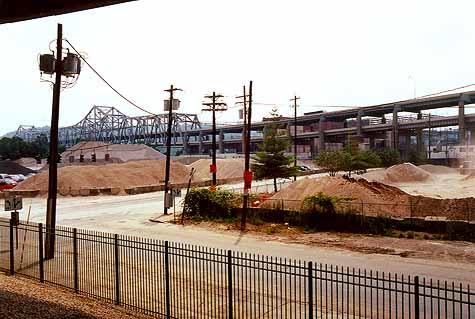
by John Schneider
Cincinnati Post 3/9/00
Sooner or later, it's gotta go.
Probably by 2012, certainly no later
than 2020, the I-71/75 Brent
Spence Bridge over the Ohio River will
be become a regional choke
point not worth repairing any more.
Originally built with three lanes in
each direction, one person in the
know says an Atlanta- like total of
fourteen lanes might be needed in 20
years.
A few years ago, a fourth lane was
squeezed onto the bridge by doing
away with the safety shoulders, perhaps
one reason the accident rate on
the Brent Spence is 750 percent higher
than the average Kentucky
freeway rate.
The Ohio-Kentucky-Indiana Regional
Council of Governments has
studied the bridge for Kentucky's
Transportation Cabinet, which owns
it. OKI considered how and when a Brent
Spence replacement should
be built and what it might look like.
Hopefully, it won't look anything like
the double-decked Brent Spence,
but more like the yellow-arched Daniel
Carter Beard Bridge carrying
I-471 over our eastern riverfronts.
With both directions of traffic open to
the sunlight, side-by-side spans
are easier to maintain and, well,
prettier. Prettier is important. For
Cincinnati and Northern Kentucky, a new
Brent Spence could be a
great way to show off, a gesture to our
bigger-city aspirations.
The world's most stunning bridges
usually nest at the necks of great
coastal bays. They are scaled to
accommodate ocean shipping. They
endure. Beautiful freshwater bridges are
more rare, but you can find
them. You can find them right here.
The World Almanac already credits the
Tri-State with two of the
nation's 30 or so ''notable'' suspension
bridges with spans over 1,000
feet: Covington's John A. Roebling
Bridge and Maysville's Simon
Kenton Memorial Bridge.

A majestic bridge - high and wide and supremely functional - may
hinder the development of Cincinnati's
far-western riverfront, now
within reach because of Paul Brown
Stadium. The wider the bridge, the
larger the dead zone beneath it. With
all those driving lanes and curvy
ramps, Superbridge and its entourage
will cast shadows that the best
riverfront planning may fail to
overcome.
For that matter, there isn't much room
for a new Brent Spence.
One avenue of OKI's thinking is to build
twin spans, one on each side
of the current Brent Spence, and then
demolish the old bridge when the
new one is complete. This geometry is
pretty tough. A hotel and a
Cinergy transformer farm stand in the
path of a wider bridge.
We don't need to guess about the impacts
of this project. Economic and
environmental modeling is so advanced
these days that we'll have a
good understanding of what will happen
to our city when Superbridge
moves 200,000 vehicles a day compared to
fewer than 150,000 now.
Will those 50,000 extra vehicles be
going further out, contributing to
more sprawl? Does Superbridge further
dilute the critical mass needed
to build a first-class light rail
system?
How about the idea of, say, 5,000 more
semi-trailer trucks climbing out
of the Ohio River Valley every day,
trailing diesel smoke to Florence
and West Chester?
Then there's the optimists' case: 20
years from now, 200,000 cars and
trucks will probabl y run cleaner than
150,000 of them do today.
Here's something else to consider: Look
for the state of Ohio to attempt
to capture the NAFTA Highway, a putative
trade link between Montreal
and Mexico City.
Right now, the NAFTA Highway is supposed
to go through
Indianapolis. Some thoughtful
Cincinnatians believe that it should come
through the Tri-State instead.
Which begs the question: Do we really
want the NAFTA Highway? It
has been suggested that hosting it would
be a prestigious honor. But
maybe the NAFTA Highway also means, for
Cincinnati, Louisville and
Memphis, dirtier air and a lot more
trucks.
Maybe we can do better.
Perhaps Cincinnati and Northern Kentucky
should focus instead on
higher-value products that don't move by
truck - biotech,
communications and Ken Griffey come to
mind.
As I think more about it, maybe
Indianapolis should get the NAFTA
Highway after all.
If it behaves and doesn't make things
worse, I could learn to love
Superbridge. Especially if it can be one
of those fog-piercing,
twin-masted, cable-stayed types more
commonly found in Asia and
Europe.
If we're going to keep things moving
around here, a new Brent Spence
is essential. But the devil's in the
details, and how we start to deal with
them is pretty important, even now.
With new and wider highways plugged into
each end of it, the Brent
Spence will soon become a burr under
Ohio and Kentucky's shared
saddle. Pressure will build to ''Do
Something!''
Keep an eye on this. My guess is persons
on both sides of the river - a
little wiser these days - will agree to
fashion a durable and symbolic
landmark.
The consensus solution will likely be a
remarkable blend of science,
economics, engineering and art.